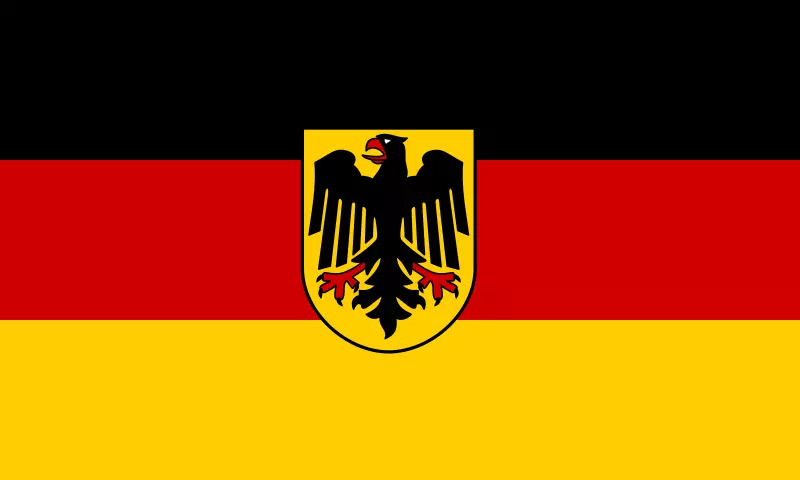Learn the value of the German flag colors which are black, red, and gold. Strength, courage, and unity are the signs of the flag design that symbolizes national values.
General Information About Germany
Country Information
- Location: Central Europe, covers 357,386 sq km
- Capital: Berlin
- Population: 83.2 million people as of 2022
- Language: German
- Government: Federal parliamentary republic
- Currency: Euro
- Economy: $46,563 (2020) GDP per capita
- Religion: Catholicism and Protestantism Christians
Neighboring Countries of Germany
Table of Content
Flag History of Germany
German Kingdom during the Middle Ages
Color Of German Flag
Symbolism of the Flag of Germany
Frequently Asked Questions
Flag history of Germany
The flag of Germany has undergone many changes throughout the country’s history. The current German flag was adopted in 1949 after World War II. It features three equal horizontal bands of black, red, and gold.
Prior to the 20th century, German states used their own flags. When Germany united in 1871, the first national flag featured a black eagle on a white background. This was replaced in 1892 by a flag with horizontal black, white, and red stripes. The Weimar Republic adopted a black, red, and gold tricolor in 1919. The Nazi regime replaced this in 1935 with a swastika flag.
German Kingdom during the Middle Ages

Germany did not exist as a unified state during the Middle Ages. The Holy Roman Empire, centered in Germany, was a political entity made up of hundreds of small kingdoms, duchies, and free cities. Emperor Charlemagne united much of the German lands under the Carolingian Empire in the 9th century.
After Charlemagne’s death, his grandsons divided the empire into three kingdoms – East Francia, Middle Francia, and West Francia. Over time, East Francia became the Kingdom of Germany and elected its first king, Otto the Great, in 962. The Holy Roman Empire persisted through the Middle Ages as a weak confederation of Germanic states.
Color Of German Flag
The colors of the German flag are black, red, and gold. The flag features three equal horizontal bands of these colors. The modern German flag was adopted in 1949.
The color black stands for determination and strength. Red represents courage, readiness to sacrifice, love, and warmth. Gold embodies intelligence, tolerance, wisdom, and freedom. These colors trace back to the uniforms worn by the Lützow Free Corps during the German War of Liberation against Napoleon in the 19th century.
Symbolism of the Flag of Germany

The German flag contains the colors black, red, and gold which each have their own significance.
Black represents strength, dignity, and determination. Red stands for courage, passion, and the willingness to sacrifice. Gold symbolizes generosity, wisdom, and enlightenment.
The horizontal tricolor design is believed to represent unity and solidarity in German culture. It reflects the egalitarian and democratic principles of modern German society.
The colors also have their origins in the uniforms worn by the Lützow Free Corps who fought against Napoleon’s forces in the 19th century. The flag thus pays tribute to the spirit of the fighters who played a key role in the movement towards German unification and sovereignty.
Frequently Asked Questions
Q: What is the capital of Germany?
Ans: The capital of Germany is Berlin. Berlin has been the capital since 1990 and the reunification of Germany.
Q: What is the population of Germany?
Ans: Germany has a population of over 83 million people as of 2022, making it the most populous country in the European Union.
Q: What language is spoken in Germany?
Ans: The official language of Germany is German. Over 95% of citizens speak German as their first language. There are also minority languages including Turkish, Kurdish, and Polish.
Q: What is the currency of Germany?
Ans: The euro (€) is the official currency used in Germany. Germany replaced the Deutsche mark with the euro in 2002.
Q: Who is the Chancellor of Germany?
Ans: The current Chancellor of Germany is Olaf Scholz. He became Chancellor in December 2021 after Angela Merkel stepped down following 16 years in power.
Q: What is Germany best known for?
Ans: Germany is renowned for its engineering innovations (cars, machinery), beer brewing tradition, high-quality manufacturing, football/soccer prowess, and influence on classical and contemporary music.
Q: What is the largest city in Germany?
Ans: Berlin is Germany’s largest city with over 3.5 million residents in its metro area. Other major cities are Hamburg, Munich, Cologne, Frankfurt, and Stuttgart.
Q: Is Germany a member of the European Union?
Ans: Yes, Germany is a founding member of the European Union (EU) and plays a leading political role within the organization.
Q: What is the climate like in Germany?
Ans: Germany has a temperate seasonal climate. Summers are warm with occasional heatwaves. Winters are cool to cold with rain, fog, snow, and ice.
Q: Does Germany use the euro?
Ans: Yes, Germany uses the euro as its official currency, having adopted it in 2002. Prior to that, its currency was the Deutsche mark.




